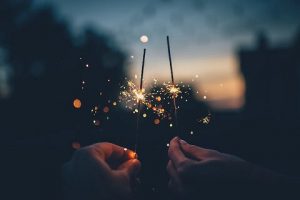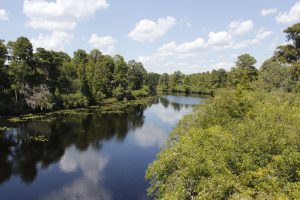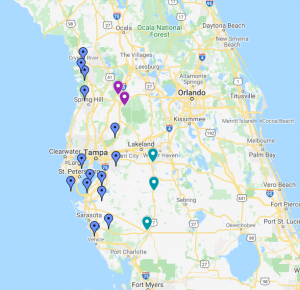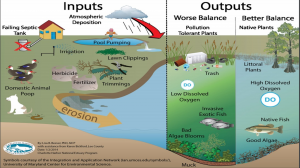A New Reason to Celebrate

As Independence Day weekend comes to a close, we may have to say goodbye to our barbecues, apple pies, and sparklers…Of course, that does not mean we have run out of things to celebrate this month! In case you did not know, July is Lakes Appreciation Month. That’s right – we have a whole month to celebrate one of the most valuable and picturesque resources on our planet. Lakes and other freshwater bodies are abundant in Florida, a phenomenon most of us have already taken advantage of through our drinking water, reclaimed water, and recreation.
Florida Lakes

Florida boasts one of the highest statistics in the country with nearly 7,800 lakes and over 76,000 stormwater ponds. These freshwater bodies are notorious for attracting an amazing array of wildlife from birds to fish to stunning reptiles, including our favorite American alligator (Alligator mississippiensis). Lakes and ponds have always been used interchangeably as terms to describe the common freshwater areas we see near homes and while driving down Florida’s many highways. It can be difficult to differentiate between the two, but experts usually define lakes as being over 1 hectare in size. Both lakes and ponds serve a similar purpose in our environment.
In Sarasota County, our lakes and ponds are almost exclusively man-made structures. One exception is Deep Hole in Myakka, which is a natural water feature. These lakes and ponds play a great role in improving our water quality by filtering stormwater and other runoff before it enters larger water systems. They also act as a protective barrier against flooding during rain events. Not only that, but many lakes help recharge our groundwater. Groundwater recharge helps us store water in our underground aquifers for when we need it later. Our lakes do a lot for us, so we can thank them by doing what we can to keep them clean and healthy.
Drinking Water
One of our most valued lakes is in neighboring Manatee County. We receive a portion of our drinking water from the Lake Manatee Dam. According to the 2019 Annual Drinking Water Report, Sarasota receives 24% of its drinking water from Manatee. That is over 900 million gallons of water per year going to our county’s households (H2OSAV). The rest of our drinking water comes from wells and rivers. Our water is treated to remove contaminants and then distributed to our homes for us to drink and use. We can help celebrate our lakes this month by drinking locally.
Holding Reclaimed
Ponds in Sarasota County can act as holding pools for reclaimed water. Reclaimed water is a great option for irrigating your lawn, as it recycles a valuable resource. It is also a known source for plant nutrients such as nitrogen and phosphorus, which are found in most fertilizers. Several communities in Sarasota County receive their reclaimed water from ponds by getting them hooked up to nearby reclaimed water pipes. Though the process can be expensive, it is a great way to conserve fresh, potable water in the long term.
Recreational
The use of lakes for recreation has been around for centuries. These popular freshwater destinations provide space for swimming, fishing, kayaking, and more. Lakes and ponds in Florida have nutrient-rich soils and mostly temperate weather all year round. This means that they can be a great environment for plants and the animals that eat them. Florida is notorious for having lush freshwater habitats all throughout the state.

Credit: Florida Museum
These habitats are often popular spaces for fishing. Lake Manatee is over 2,500 acres, and beyond providing water to both Manatee and Sarasota Counties, is a great spot to fish. According to the Herald Tribune, the lake is home to several species of game fish, including largemouth bass, bluegill, speckled perch, shellcracker, stumpknocker, sunshine bass, and giant channel catfish. That is quite the variety! You can access Lake Manatee through Lake Manatee State Park most days of the year.

Outside of fishing, swimming is another popular pastime in Florida’s abundant lakes. Though there is nothing more refreshing than a cool dip in the lake during a hot, summer day, please take care to practice water safety. Swim during daylight hours only, do not feed alligators, and try to have at least one supervising adult.
Of course, an excellent way to enjoy the beauty of our state’s lakes is through kayaking and canoeing. Our district has nearly twenty different paddling sites, giving you a variety of places to visit. Check out Paddle Florida’s map to find out where exactly they are located. No matter how you play, do your best to keep our lakes in great shape before you leave a site. That way, everyone can enjoy them for their natural beauty!
Our recreation opportunities in Florida bring the state a hefty amount of revenue each year. In 2016, it was estimated that nearly 75% of the state’s population engaged in some kind of outdoor recreational activity. In one 2016 study, researchers found that outdoor recreation activities generated $37 billion from residents and $126 billion from out-of-state visitors. This equates to about a 15% contribution to the state’s total economic output. Our lakes are not only an important resource for our physical and mental health, but they are also an essential part of our economy.
Protecting Our Lakes
Every five years, our district creates a Regional Water Supply Plan that helps us protect lakes and other natural water bodies. This plan contains information about managing Minimum Flows and Levels required to keep our freshwater environments pristine. It also includes information on the water supply, water resource development, and funding opportunities for each. Of course, the plan’s primary purpose is to prepare for any potential water shortages by implementing a recovery plan when necessary.
Our state’s natural lakes are also protected by the Department of Environmental Protection’s Clean Water Act. The act, passed in 1972, limits the amount of pollutants that can be discharged into our waters. These pollutants include oil and other hazardous substances, which are moderated under the Total Maximum Daily Load Program. Only those who possess a National Pollutant Discharge Elimination System (NPDES) permit are allowed to discharge any substances. The legislation also accounts for ways to improve the quality of already impaired waters and offers funding for any projects dedicated to reducing nonpoint source pollution.
You too can participate in protecting our local water bodies. If you have a pond or lake near your home, consider taking the following actions:
- Reduce your inputs to build up your pond’s natural defenses.

Diagram showing various pond inputs and their corresponding outputs - Work with your pond manager to adopt an integrated approach to aquatic weed management.
- Reduce fertilizer use.
- Keep lawn clippings and tree debris out of your stormwater pipes and ponds.
- Create or enhance the pond’s littoral zone with native wetland plants to restore the natural food web.
- Add a low-maintenance buffer around the perimeter of your pond to secure bank sediments and allow for additional removal of nutrients and other non-point source pollution.
- Conduct a Stormwater Pond Habitat Assessment to rate the overall ability of your pond(s) to provide habitat to invertebrates, fish, and birds.
- Use County resources to help you achieve any and all of the above. Call the Neighborhood Environmental Stewardship Team (NEST) or University of Florida IFAS Extension at 941-861-5000.
- Abide by Sarasota County’s Water Pollution Control and Fertilizer and Landscape Management Codes and reporting any violations to the EPD at 941-861-5000.
For more information on Lakes Appreciation Month, check out this website from the North American Lake Management Society.
An Equal Opportunity Institution. UF/IFAS Extension, University of Florida, Institute of Food and Agricultural Sciences, Nick T. Place, dean for UF/IFAS Extension. Single copies of UF/IFAS Extension publications (excluding 4-H and youth publications) are available free to Florida residents from county UF/IFAS Extension offices. Sarasota County prohibits discrimination in all services, programs or activities. View the complete policy at www.scgov.net/ADA.
 0
0

